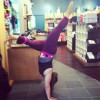I recently completed my certification in hands-on assists and have begun a private coaching practice offering hands-on assists to yoga students throughout their practice.
As a dancer, I find thismutual fluidity beautiful. In giving and reviving this practice, it feels like a duet, with reciprocal kinetic energy filling the shape of breath and asana. During training, we were told that as studio communities and teachers, we should not offer students the option of not receiving these physical assists—that even survivors of physical trauma could find healing via physical contact.
We were told that injuries could mend with the heat of someone else’s touch; that if a student protests, we should gently push them to incorporate physical assists into their practice.
Yes, I get that; but there are very real issues at stake in offering hands-on assists to trauma survivors that teachers and trainers are not addressing.
Elaine Scarry writes that pain endured in trauma is world shattering, that in the lived experience of pain, the external world disappears and sense of self and being become localized in the sensation of bodily pain. Pain disintegrates the world. The remembrance of traumatic pain can also shatter the world and disrupt the present.
I know this myself as a survivor of sexual assault. This is what it feels like to be triggered: time and setting melt away and you are left with nothing outside of that act, that moment. The memory of the trauma obliterates all else; that moment In your past—that which should be a fixed entity—invades your preset and robs you of the now of yourself in your present. All else shrinks away and it is just you, in your head, reliving the assault.
At least, this is how I experience moments of re-trauma.
As a sexual assault survivor, my yoga practice brought me back into my own body. Instead of being the receptacle-literal and figurative-for someone else’s demands and desires and a stage from which another person’s power can be enacted, my body is mine. My body is mine to shape, to fill with breath, to explore and to understand.
When a student tells a teacher that they do not want to receive hands on assists, are we really honoring them? I love giving and receiving physical assists, but I have also had to do so much work both on and off of the mat to understand the place of this intimacy as a trauma survivor.
In yoga practice we step onto our mat, out of our heads and into the lived experience of ourselves in the present. In Baptiste Power Vinyasa we say, “if you are not here, you are nowhere.” The past is something that is gone to us, the future is not yet real. There is only the now.
As an extension of our yoga practice, when offering physical assists to trauma survivors, this touch should enhance the connection to the present, and never put the yoga practitioner at risk of falling into the triggers and terrors of their past.
The disintegration that trauma wreaks can be mended via yoga practice, but unless taught effectively and safely, we place our yoga students in danger of triggering.
Like elephant journal on Facebook.
Assistant Ed: Miciah Bennett/Ed: Bryonie Wise











Read 2 comments and reply